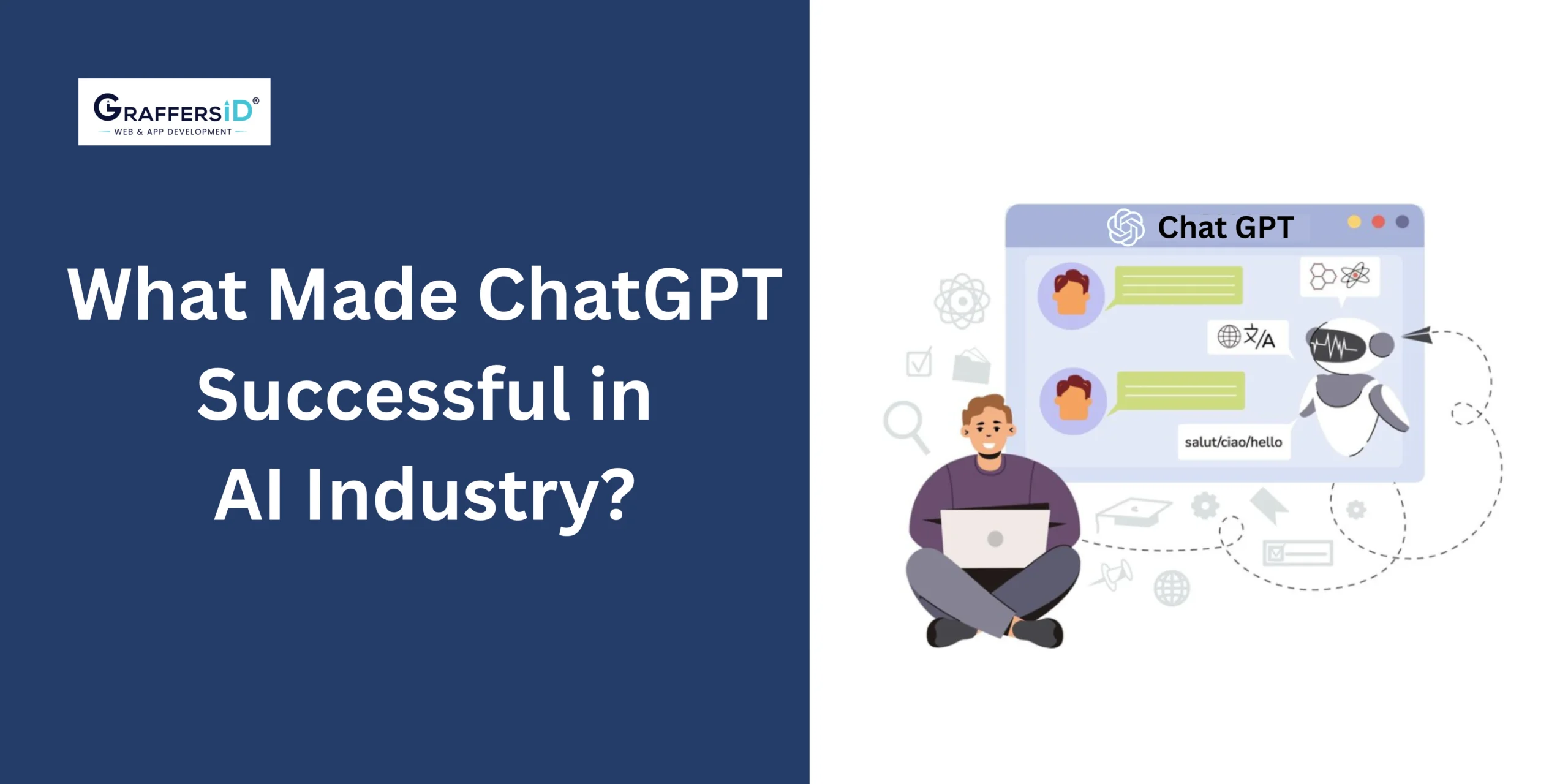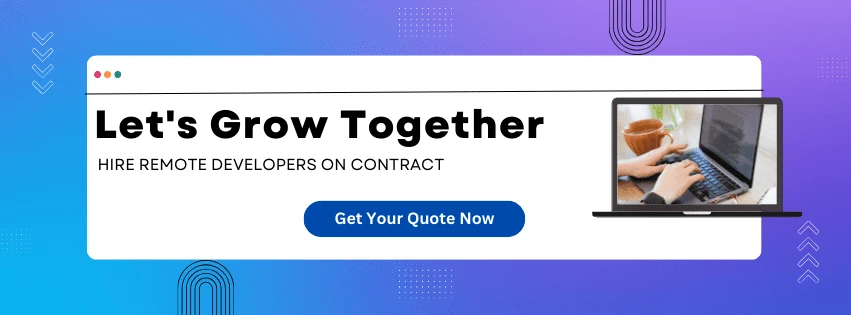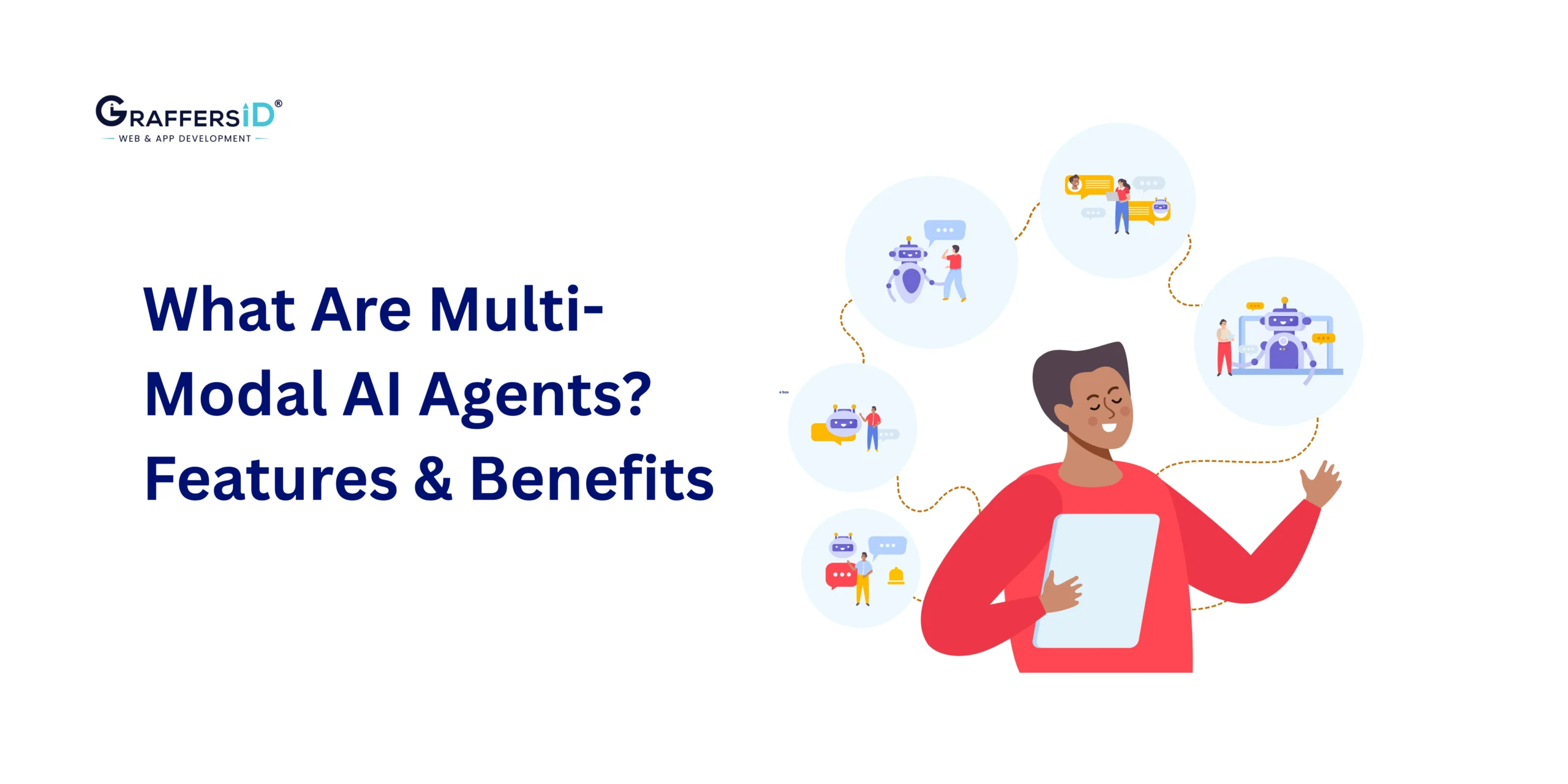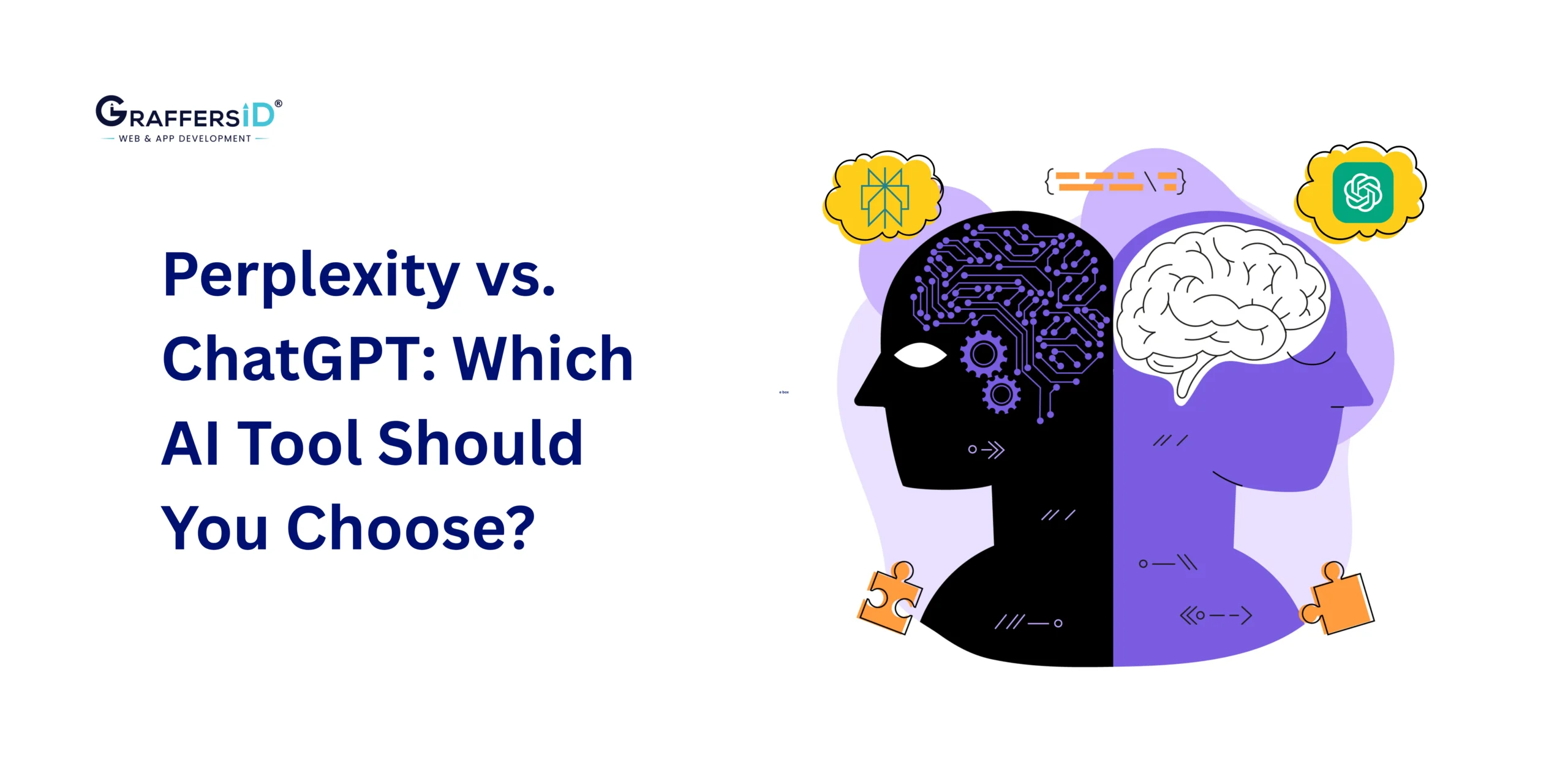In under five years, ChatGPT has evolved from a simple AI chatbot into a core engine of digital transformation. As of 2026, it powers real-world applications across industries, automating customer support, enhancing education and product design, accelerating software development, and transforming enterprise research workflows.
For today’s business leaders and tech decision-makers, ChatGPT is not just a conversational model; it’s a productivity platform that blends multimodal understanding, contextual reasoning, and real-time personalization. It represents the next stage of human–AI collaboration, where machines think, create, and communicate almost like humans.
But what exactly made ChatGPT the most dominant AI model in a crowded market of LLMs? In this 2026 analysis, we break down the key technologies, design strategies, and ecosystem advantages that helped OpenAI’s ChatGPT redefine the global AI landscape.
What is ChatGPT (2026 Version)?

ChatGPT, developed by OpenAI, is a conversational AI built on the Generative Pretrained Transformer (GPT) architecture. It leverages deep learning and transformer models to understand, generate, and respond to natural language inputs.
In 2026, the latest versions: GPT-4.5 and GPT-4o (omni) have redefined multimodal AI. Unlike earlier models that only processed text, GPT-4o integrates voice, image, video, and code, enabling richer and faster interaction across devices and platforms.
Read More: Which OpenAI ChatGPT Version Should You Use in 2026? (Complete Business Guide)
Best Features of ChatGPT in 2026
ChatGPT’s 2026 evolution is a direct result of OpenAI’s user-first development and rapid iteration strategy. Here are the standout features that make it indispensable for individuals and enterprises alike:

1. Multimodal Capabilities
ChatGPT-4o can interpret and respond to text, images, audio, and video in a single conversation. Users can upload screenshots, data charts, or documents and receive instant, contextual analysis. Voice-based interactions are nearly human-like, enabling hands-free, real-time conversations.
2. Contextual Understanding & Reasoning
With improved Natural Language Understanding (NLU), ChatGPT comprehends complex, multi-turn contexts. It now delivers responses that reflect logical reasoning, emotional tone, and domain knowledge: key for enterprise applications.
3. Memory and Personalization
The persistent memory feature allows ChatGPT to remember user preferences, tone, and previous interactions. This has transformed it from a static chatbot to a personalized AI collaborator that adapts to each user or team.
4. Voice Interaction & Real-Time Responses
ChatGPT’s voice-to-voice mode enables natural, instant communication. Its near-zero latency responses are comparable to human conversation, bridging the gap between AI and real-world dialogue.
5. Versatility
ChatGPT is a latest AI-powered tool, offering a wide range of versatile capabilities. It can generate text from scratch or fine-tune existing content, answer questions, translate between languages, summarize long texts, and more. With ChatGPT, copywriters can save time and energy on mundane tasks while still producing high-quality content.
6. Plugin & Tool Ecosystem
The GPT Store now allows users to create, deploy, and share their own GPTs. Integration with tools like Canva, Google Drive, Zapier, and WolframAlpha expands its use cases beyond chat to content creation, data analytics, automation, and design.
7. Developer-Friendly APIs
OpenAI’s APIs make it easy for developers to embed ChatGPT’s capabilities into websites, apps, and enterprise platforms, accelerating innovation across industries.
What Makes ChatGPT Stand Out from Other AI Models?
While many AI chatbots exist in 2026, ChatGPT remains unmatched in scale, accessibility, and ecosystem maturity. Here are the six core technologies driving that distinction:
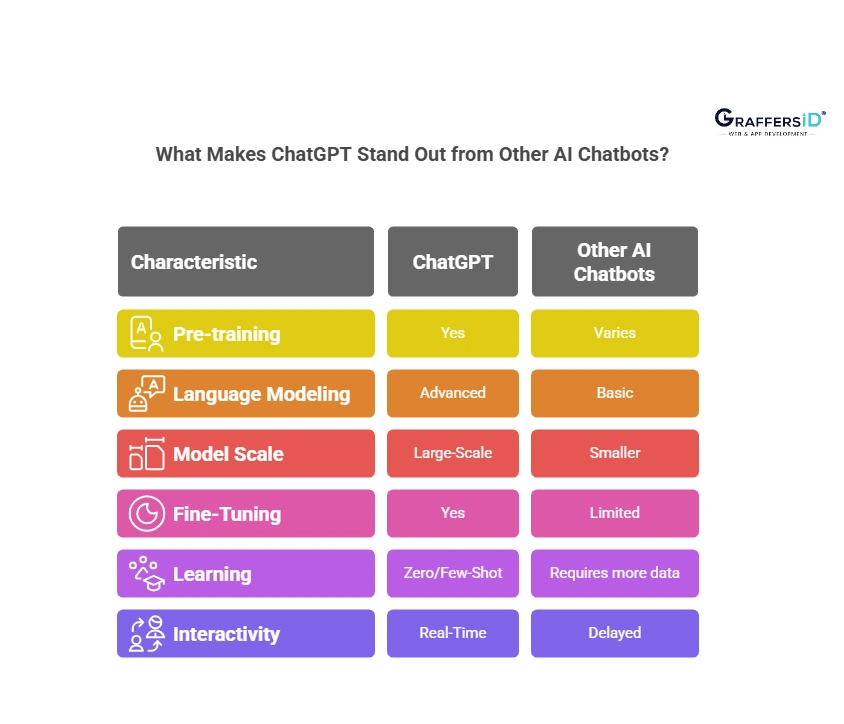
1. Massive Pretraining Foundation
Pre-training is a technique in machine learning that enables models to learn from large amounts of text data. ChatGPT is one such model that utilizes the transformer architecture for pre-training. Trained on an extensive dataset of web text, research papers, and code, ChatGPT’s pretraining enables it to understand language patterns, context, and intent with exceptional depth, setting a new standard for AI fluency.
2. Advanced Language Modeling
Language modeling is an AI-driven approach to language generation that is capable of producing human-like text responses. OpenAI’s transformer-based architecture enables contextual reasoning and content generation that mirrors human logic. ChatGPT produces structured, nuanced responses that fit business, technical, or creative needs.
3. Large-Scale Model Parameters
ChatGPT is a large-scale AI model with over 175 billion parameters GPT-4o delivers advanced comprehension, code understanding, and content generation, empowering developers, marketers, and enterprises to build next-gen products.
4. Fine-Tuning & Domain Adaptation
Through custom GPTs, organizations can now fine-tune ChatGPT for domain-specific tasks, such as legal summarization, medical triage, or financial forecasting, without requiring deep AI expertise. This flexibility makes it an invaluable tool for copywriters looking to maximize their output while saving time and energy.
5. Zero-Shot & Few-Shot Learning
Zero-shot learning is an advanced and powerful form of artificial intelligence (AI) that can respond to questions and perform tasks it hasn’t seen during the training process. ChatGPT can perform new tasks with minimal examples, crucial for startups and enterprises wanting scalable, cost-effective automation. It eliminates retraining costs while maintaining contextual accuracy.
6. Real-Time Interactivity
ChatGPT is an innovative natural language processing technology that provides an interactive, conversational interface for users. Instant response times and API integration make ChatGPT a preferred choice for customer support, automation, and education platforms that demand real-time intelligence.
How ChatGPT Enhances User Experiences in 2026?
ChatGPT is an AI-powered platform that is revolutionizing the way businesses communicate with their customers. OpenAI’s focus on human-AI collaboration has made ChatGPT the most emotionally intelligent and context-aware conversational system on the market. Here’s how it redefines digital interaction:
- Emotional Intelligence: GPT-4o adjusts tone and vocabulary based on user emotion, calm, empathetic, or professional, enhancing trust and user satisfaction.
- Instant Productivity: From writing marketing emails to generating SQL queries or analyzing PDFs, ChatGPT handles multi-step tasks autonomously.
- Multilingual Support: ChatGPT is a global assistant that supports 200+ languages, helping global teams collaborate smoothly.
- Voice-to-Voice Conversations: Desktop and mobile users can communicate with ChatGPT like with a colleague; ideal for accessibility and real-time ideation.
- Visual Understanding: ChatGPT is incredibly useful for students, analysts, and designers as it can analyze screenshots, graphs, and diagrams and extract insights instantly.
Why ChatGPT Became a Game-Changer in the AI World?
ChatGPT’s success story lies in a blend of early accessibility, rapid iteration, and community-driven innovation. Let’s break down the main reasons for its global adoption:
- Democratized Access: OpenAI made ChatGPT publicly available before most competitors, collecting user feedback at scale and rapidly improving its performance and alignment.
- Platform Independence: ChatGPT is accessible via web, mobile, API, and third-party integrations, making it platform-agnostic and easier to embed into any workflow.
- Community Innovation: With the launch of custom GPTs and the GPT Store, OpenAI turned users into co-creators, fueling organic innovation and niche applications.
- Fast Iteration Cycle: From GPT-3.5 to GPT-4.5 and 4o, OpenAI maintained unmatched release speed, ensuring constant performance, safety, and feature upgrades.
- Human-AI Collaboration Focus: Unlike older automation tools, ChatGPT doesn’t replace users; it amplifies human productivity. Developers code faster, marketers ideate better, and analysts gain instant insights.
- Global Enterprise Adoption: From education and healthcare to finance and logistics, enterprises now deploy ChatGPT for support, documentation, onboarding, and even AI-powered product interfaces.
Benefits of Using AI Chatbots like ChatGPT
Beyond boosting productivity, ChatGPT offers both tangible and strategic advantages. Using an AI-powered chatbot can bring several benefits to businesses, including:
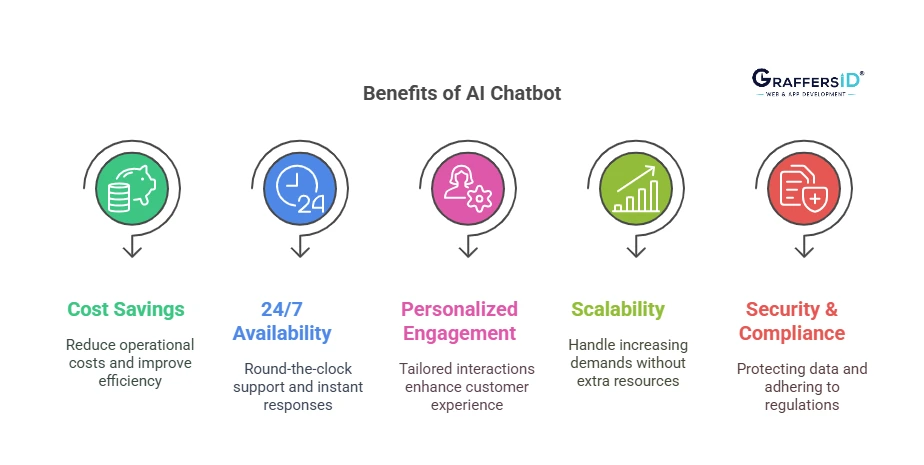
-
Cost Efficiency: Automation of Tier-1 support, content generation, and analysis reduces human workload and operational costs.
-
24/7 Availability: ChatGPT can provide automated customer support and answer questions around the clock, without time-zone limitations.
- Personalized Interactions: Persistent memory ensures context-rich, consistent communication.
-
Scalability: ChatGPT handles millions of queries concurrently with no degradation in performance.
- Security & Compliance: Audit logs, admin dashboards, encrypted data processing, and regional hosting options are all included in enterprise plans.
These benefits highlight how ChatGPT has evolved from a conversational assistant into a scalable AI infrastructure for enterprises.
Read More: OpenAI’s GPT vs. Google Gemini: Which AI Model is Better for Workflow Automation in 2026?
OpenAI vs. Other Leading AI Models in 2026: Claude, Gemini & LLaMA
The generative AI market is now highly competitive as of 2026, with Anthropic’s Claude, Google’s Gemini, and Meta’s LLaMA challenging OpenAI. However, ChatGPT’s ecosystem advantage keeps it ahead.

1. Claude by Anthropic
Claude, created by Anthropic, prioritizes steerability, security, and human-like assistance. Its Constitutional AI architecture prioritizes ethical alignment and safety. When it comes to adaptability, multimodal support (text, image, and voice), and complex coding tasks, ChatGPT performs better than Claude with richer multimodal support and a broader API ecosystem. Strong at structured reasoning but limited in multimodal and developer tools.
2. Gemini by Google DeepMind
Google’s flagship AI model, Gemini, integrates tightly with Google Search and Workspace. Gemini excels in scientific reasoning and vision-language tasks. It is perfect for technical tasks, particularly those that require linking vision and language. However, in comparison to OpenAI, it remains confined to the Google ecosystem, limiting flexibility and third-party adoption.
3. LLaMA by Meta AI
Large Language Model Meta AI, or LLaMA, is Meta’s open-source strategy for facilitating access to AI. With a focus on open-access innovation, Meta’s LLaMA 3 series allows researchers and developers to fine-tune and use private hosting. More recent versions are optimized for inference efficiency, and their open weights provide maximum flexibility. However, LLaMA is not as versatile as ChatGPT, lacks built-in multimodal capabilities, and has easy deployment.
While Claude emphasizes safety, Gemini focuses on search integration, and LLaMA promotes openness; ChatGPT’s balance of usability, scalability, and multimodality keeps it dominant.
Conclusion
ChatGPT’s evolution marks the beginning of a new era in intelligent automation, one where AI doesn’t just respond, but reasons, learns, and collaborates. By 2026, generative AI is expected to move beyond content creation into autonomous decision-making, workflow orchestration, and real-time product innovation, reshaping how businesses operate at every level.
For digital leaders, ChatGPT represents the blueprint for building scalable, human-centric AI ecosystems. Its multimodal capabilities, natural language understanding, and adaptability across industries make it a cornerstone for enterprise transformation in 2026 and beyond.
As AI continues to advance, the question is no longer “Should we integrate AI?” but “How fast can we adapt to stay ahead?”
Looking to develop custom AI chatbots, automate complex business workflows, or integrate generative AI into your products, GraffersID is your trusted partner.
Hire pre-vetted AI developers in India skilled in OpenAI, GPT-based frameworks, and conversational AI to build intelligent, future-ready solutions tailored to your business goals.
